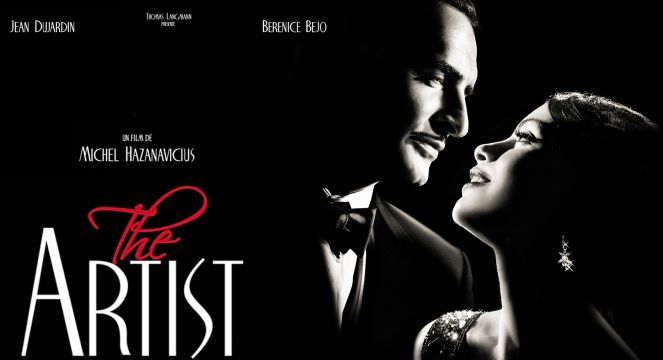The Artist follows silent film star George Valentin (Jean Dujardin), who just can't get enough of himself. He soaks up attention like a long-dried sponge absorbs some much-needed water. He's larger than life and, in his mind, larger even than his projected image which appears on the big screen. Following the successful premiere of his latest hit, he has a run-in with a beautiful girl named Peppy Miller (Bérénice Bejo) while in the midst of an eager press corps. Suddenly, George and Peppy are the talk of the tabloids and entertainment rags. They appear together on the cover of Variety, angering Kinograph Studios bossman Al Zimmer (John Goodman) because the added press for his star means news of the movie's successful debut has been relegated to page five. Soon, Peppy's living the dream up on the silver screen, first as an extra and, with every new picture, moving on up the credit list until she's poised to become Kinograph's newest and hottest attraction. In fact, she's the perfect face -- complete with her painted-on beauty mark courtesy of none other than George himself -- to head up Kinograph's new sound division, which Zimmer and company believe to be the future of filmed entertainment. But George will have none of this talking business. He sets out to prove that silent films remain king, financing his own project while Kinograph and Peppy set out to make history -- and a fortune.
Director Michel Hazanavicius had been fantasizing about making a silent film for many years, both because many filmmakers he admires emerged in the silent era, and because of the image-driven nature of the form. According to Hazanavicius, his wish to make a silent film was at first not taken seriously, but after the financial success of his spy-film pastiches OSS 117: Cairo, Nest of Spies, and OSS 117: Lost in Rio, producers started to express interest. The forming of the film's narrative started with Hazanavicius' desire to work again with actors Jean Dujardin and Bérénice Bejo (Hazanavicius' wife), who had both starred in OSS 117: Cairo, Nest of Spies. Hazanavicius chose the form of a melodrama, mostly because he thought many of the films from the silent era that have aged best are of that genre. He did extensive research about 1920s Hollywood, and studied silent films to find the right techniques to make the story comprehensible without having to use too many intertitles. The screenplay took four months to write.
After having had its world premiere at the 64th Cannes Film Festival, The Artist was released in select cities on November 25th, 2011 before eventually expanding. On February 26th, 2012, the film ended up winning 5 Academy Awards for Best Picture, Best Director (Michel Hazanavicius), Best Actor (Jean Dujardin), Best Costume Design, and Best Original Score. It was also the first movie presented in the 4:3 aspect ratio to win since 1953's From Here to Eternity. Additionally, it was the first black-and-white film to win since 1993's Schindler's List, though the latter contained limited colour sequences; it was the first 100% black-and-white film to win since 1960's The Apartment.
After having had its world premiere at the 64th Cannes Film Festival, The Artist was released in select cities on November 25th, 2011 before eventually expanding. On February 26th, 2012, the film ended up winning 5 Academy Awards for Best Picture, Best Director (Michel Hazanavicius), Best Actor (Jean Dujardin), Best Costume Design, and Best Original Score. It was also the first movie presented in the 4:3 aspect ratio to win since 1953's From Here to Eternity. Additionally, it was the first black-and-white film to win since 1993's Schindler's List, though the latter contained limited colour sequences; it was the first 100% black-and-white film to win since 1960's The Apartment.
For a more in-depth discussion, feel free to listen to this podcast episode with me and Dan Bayer of Next Best Picture.
